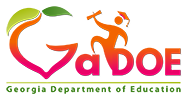Georgia AEM Vision
All Georgia students will have access to educational materials in the most appropriate format and with the technology to make those formats accessible.
Kai Ownes, 2021 Bulloch County Valedictorian, describing how Assistive Technology and Accessible Educational Material supported his success in the classroom.
-
Create an Implementation manual and other documents and resources.
-
Enhance and/or create data collection tools and analyze data to guide TA under a model of general supervision and Georgia's Continuous Improvement Plan.
-
Design a platform and continually update with resources created during the AEM Cohort.
-
Integrate AEM in other existing GaDOE projects.
Accessible educational materials (AEM) are print - and technology-based educational materials, including printed and electronic textbooks and related core materials that are designed or enhanced in a way that makes them usable across the widest range of learner variability, regardless of format (e.g., print, digital, graphic, audio, video).
Accessible formats provide the same information in another form to address the barriers text-based materials can present for some learners. Examples of accessible formats include audio, braille, large print, tactile graphics, and digital text conforming with accessibility standards. See Accessible Formats.
Accessible digital materials are media-rich sources of course content that have been designed to conform to digital accessibility standards in order to make them usable to a wide range of learners. Examples include websites, ebooks, podcasts and videos that include not only text but graphics, audio and other media and require interaction. See Designing for Accessibility with POUR.
Accessible technologies are the hardware devices and software that provide learners with access to the content in accessible digital materials. These technologies are designed to be flexible and provide supports that benefit everyone - they are universally designed.
Assistive technologies are designed to address specific barriers learners with disabilities may face when they interact with their materials. Examples of assistive technology include text-to-speech, screen readers and speech recognition. Assistive technology services assist learners with disabilities in selecting, acquiring and using the assistive technologies that are the best match for them.
In practice, the line between what is accessible and assistive technology can become blurred, especially as more assistive technology is included as built-in accessibility features on the consumer devices many learners and families already own.
For more information, visit
cast.org.

